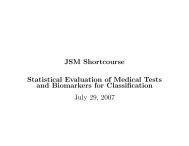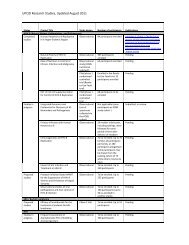Summer Undergraduate Research Program - Fred Hutchinson ...
Summer Undergraduate Research Program - Fred Hutchinson ...
Summer Undergraduate Research Program - Fred Hutchinson ...
You also want an ePaper? Increase the reach of your titles
YUMPU automatically turns print PDFs into web optimized ePapers that Google loves.
Investigating a Small Molecule Inhibitor of Aurora<br />
Kinase-A in Ras-driven Pancreas Cancer Cells<br />
Brian W. Wakefield1,2 ; Amy E. Chang2 ; Vikas K. Goel, Ph.D2 ; Sunil R. Hingorani, M.D., Ph.D. 2<br />
1Whitman College, Walla Walla, WA; 2<strong>Fred</strong> <strong>Hutchinson</strong> Cancer <strong>Research</strong> Center, Seattle, WA<br />
2010 Best Poster Presentation Award<br />
RalGTPase Pulldown Assay: RalA activity decreases with AKAi-1.<br />
Results<br />
Cell Proliferation: AKAi-1 inhibits cell growth in KPC cells.<br />
AKA<br />
P + P+<br />
Fig. 10: Western Blot. KPC cells<br />
treated with AKAi-1 or vehicle for 36<br />
hours. Signal intensity normalized to<br />
GST loading control. Inhibition of<br />
AKA by AKAi-1 causes downregulation<br />
of active RalA.<br />
P + P+<br />
AKA<br />
Conclusions<br />
AKAi-1 treatment in primary KPC cell lines:<br />
Inhibits cell proliferation with increased G2/M arrest<br />
Increases apoptosis<br />
These effects occurred in a concentration-dependent manner.<br />
Abstract<br />
Pancreatic ductal adenocarcinoma (PDA) is the fourth leading cause of cancerrelated<br />
deaths in the United States and, with a five-year survival rate of less<br />
than 5%, is almost uniformly fatal. Current therapies are only able to improve<br />
survival by several weeks and new approaches to the study of this disease are<br />
therefore imperative. Over 90% of pancreas cancers have an activating<br />
mutation in the KRAS proto-oncogene while 75% have an inactivating<br />
mutation in the tumor suppressor gene, TP53. We have shown that<br />
endogenous expression of KrasG12D and Trp53R172H in the pancreata of mice<br />
induces disease that mimics human pancreas cancer from precursor lesions to<br />
fully invasive and metastatic PDA. Direct inhibition of oncogenic KRAS in<br />
patients has proved challenging, causing a shift in focus toward its downstream<br />
effectors. The small GTPase, RalA, is downstream target of Ras signaling,<br />
necessary for Ras-mediated oncogenesis, and is also activated by Aurora<br />
Kinase A (AKA). We describe the effects of a small molecule inhibitor of<br />
AKA (AKAi-1) on primary tumor cells derived from the pancreata of mice<br />
expressing oncogenic KrasG12D and mutant Trp53R172H . Standard assay<br />
methods for apoptosis, proliferation, and cell cycle progression were used.<br />
These experiments were designed to determine whether this drug should<br />
proceed to preclinical trials in the autochthonous mouse model.<br />
CDC25<br />
No additive or synergistic effects were observed with simultaneous treatment<br />
of AKAi-1 and Gemcitabine.<br />
Fig. 3: Aurora Kinase A and Kras converge to activate the small GTPase RalA<br />
These data suggest that AKAi-1 may be effective in treating Ras-driven<br />
carcinomas and justify testing this inhibitor in our preclinical mouse model.<br />
AKAi-1<br />
1 2 5 10 - - - 1 2 5 10 1 2 5 10<br />
(µM)<br />
GEM<br />
- - - - 1 5 10 1 1 1 1 5 5 5 5<br />
(nM)<br />
Fig. 5: Growth inhibition by AKAi-1 in KPC cells. Concentration-dependent inhibition was seen in<br />
cells treated with AKAi-1 as compared to DMSO control. No additive or synergistic effects were<br />
observed from co-administration of AKAi-1 with Gemcitabine.<br />
Cell Cycle: AKAi-1 promotes G2/M arrest in KPC cells<br />
Vehicle<br />
Cell Cycle<br />
Progression<br />
Background<br />
Targeted expression of oncogenic KrasG12D to the pancreas initiates<br />
pancreas cancer1 Concomitant expression of mutant Trp53 cooperates to accelerate widely<br />
metastatic disease2 Future Directions<br />
157<br />
To gain a better understanding of the molecular interactions between Kras<br />
and RalA, we will quantify the effects on RalA activity of silencing KrasG12D using shRNA in an inducible system.<br />
Mouse PDA Cells NIH3T3 Cells<br />
Control V33 V28 V24 V14 C. V28 V24 V14<br />
DOX - + - + - + - + - + + + + +<br />
AKAi-1<br />
0.5 µM<br />
AKAi-1<br />
2.5 µM<br />
AKAi-1<br />
- 0.5 1 2.5 5 - - - 0.5 0.5 1 1<br />
(µM)<br />
GEM<br />
- - - - - - 2 5 2 5 2 5<br />
(nM)<br />
Fig. 6: Effect of AKAi-1on cell cycle progression in KPC cells. Concentration-dependent increase in<br />
G2/M arrest was seen in AKAi-1-treated cells. No additive or synergistic effects were observed from coadministration<br />
of AKAi-1 with Gemcitabine. Fig7: Representative plots.<br />
Apoptosis: AKAi-1 increases apoptosis in KPC cells<br />
Materials and Methods<br />
Experiments were conducted in primary cell lines derived from murine<br />
pancreatic tumors (KPC):<br />
KPC<br />
LSL-KrasG12D activating mutation<br />
LSL-Trp53R172H mutation<br />
Fig. 1: Conditional LSL-KRASG12D and LSL-Trp53R172H (KPC) alleles and generation<br />
of functional mutant via Cre recombinase2 Pdx-1-Cre<br />
Fig. 11: Western blot. KPC cells (left) infected with a Doxycyclin-inducible TripZ vector (V) carrying<br />
KrasG12D shRNA show silencing of oncogenic Kras when exposed to Doxycyclin. NIH3T3 cells (right)<br />
Fig. 2b: Specimen<br />
from same mouse<br />
showing hepatic<br />
metastases (black<br />
arrows) and a large<br />
head-of-the-pancreas<br />
primary tumor ( * ) 2<br />
Fig. 2a: Gross<br />
pathological<br />
photograph of<br />
metastatic<br />
PDA in a KPC<br />
mouse2 expressing wild-type Kras show no effect.<br />
Ras activity will be quantified with a RasGTPase pull-down assay<br />
RalA activity will be quantified with a RalGTPase pull-down assay<br />
We will administer AKAi-1 to KPC animals with established tumors alone<br />
and in combination with Gemcitabine. The results of the in vivo study together<br />
with the in vitro data will help determine whether this drug should proceed to<br />
clinical trials.<br />
Vehicle Control<br />
AKAi-1 0.5µM AKAi-1 1.0µM<br />
Fig. 8: Representative apoptosis flow cytometry data from KPC cells. Double positive (upper right,<br />
circled) population represents late apoptotic and dead cells. Annexin V positive population (lower<br />
right) represents early apoptotic cells.<br />
Fig. 4: Western blot. KPC tumor cells show high levels of AKA expression and expression of<br />
RalA<br />
Fig. 2d: Welldifferentiated<br />
liver<br />
metastasis (m) and<br />
surrounding normal<br />
tissue (h) 2<br />
Fig. 2c: Welldifferentiated,<br />
glandular<br />
PDA2 Cell Proliferation: cells were plated in 96-well plates and exposed to a<br />
spectrum of AKAi-1 and Gemcitabine concentrations alone and in<br />
combination. Proliferation was analyzed by WST-1 and absorbance was<br />
read at 450nm.<br />
References<br />
1.Hingorani, Sunil et al. “Preinvasive and Invasive Ductal Pancreatic Cancer and its Early Detection in the Mouse.”<br />
Cancer Cell 4(2003): 437-450.<br />
2.Hingorani, Sunil et al. “Trp53R172H and KrasG12D cooperate to promote chromosomal instability and widely<br />
metastatic pancreatic ductal adenocarcinoma in mice.” Cancer Cell 7(2005): 469-483<br />
3.Brunner, Thomas et al. “Farnesyltransferase Inhibitors: An Overview of the Results of Preclinical and Clinical<br />
Investigations.” Cancer <strong>Research</strong> 63(2003): 5656-5668.<br />
4.Lim, Kian-Huat et al. “Aurora-A Phosphorylates, Activates, and Relocalizes the Small GTPase RalA.” Molecular<br />
and Cellular Biology 30(2010): 508-523<br />
Cell Cycle and Apoptosis: cells were plated in 60mm plates and<br />
exposed to a spectrum of AKAi-1 and Gemcitabine concentrations alone and<br />
in combination. Cell cycle was analyzed by propidium iodide staining and<br />
flow cytometry. Apoptosis was analyzed by PE-Annexin V staining and<br />
flow cytometry.<br />
Direct inhibition of constitutively active oncogenic Kras or its upstream<br />
regulators ineffective or impossible in clinical populations 3<br />
Targeted inhibition of downstream effectors of Kras may reveal new<br />
potential therapeutic targets<br />
RalA Activity: Active, phosphorylated RalA was quantified using a<br />
RalGTP assay (MilliporeTM ). Active RalA was pulled down by RalBP1 as<br />
per manufacturer’s instructions and quantified by western blot.<br />
Acknowledgements<br />
Hypotheses<br />
Targeting specific downstream effectors of Kras maybe an effective method<br />
of inhibiting Ras-driven PDA<br />
This program was supported by a research grant from the Howard Hughes Medical Institute and Whitman College.<br />
I would personally like to thank Dr. Sunil Hingorani, Dr. Vikas Goel, Amy Chang, Natalie Wong, Layken Fletcher, Dr.<br />
Paolo Provenzano, and Dr. Libing Feng for their help and guidance during this internship.<br />
AKAi-1<br />
- 0.5 1 2.5 5 - - - 0.5 0.5 1 1<br />
(µM)<br />
GEM<br />
- - - - - - 5 10 5 10 5 10<br />
(nM)<br />
Fig. 9: Effect of AKAi-1on apoptosis in KPC cells. Concentration-dependent increase in apoptosis was<br />
seen in AKAi-1-treated cells. Effect plateaued near IC50 value for AKAi-1 (2.06 µM). Concentrationdependent<br />
increase in apoptosis was also observed for Gemcitabine treatments. No additive or<br />
synergistic effects were observed from co-administration of AKAi-1 with Gemcitabine.<br />
Knockdown of KrasG12D by shRNA: Cells were infected with<br />
Doxycyclin-inducible TripZ vectors containing Kras shRNA. Knockdown<br />
efficiency was estimated by western blot.<br />
Using RalA to link Aurora Kinase A (AKA) and Kras validates AKA as a<br />
therapeutic target in treatment of PDA
















